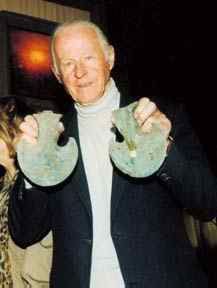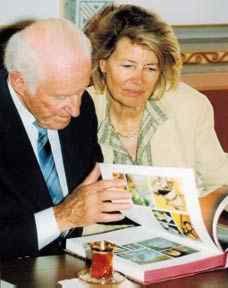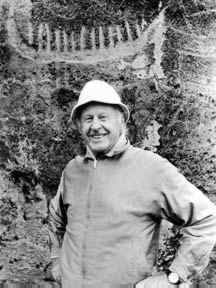|

Autumn 1999 (7.3)
Pages
96-97
Thor Heyerdahl
in Baku
Norwegian
Archeologist Identifies
Azerbaijan as Early Cradle of Civilization
by
Betty Blair
Other articles related to Thor Heyerdahl:
(1) Thor Heyerdahl in Azerbaijan: KON-TIKI
Man
by Betty Blair (AI 3:1, Spring 1995)
(2) The Azerbaijan Connection: Challenging
Euro-Centric Theories of Migration by Heyerdahl (AI 3:1, Spring 1995)
(3) Azerbaijan's
Primal Music, Norwegians Find 'The Land We Come From' (AI 5.4, Winter 1997)
(4) Scandinavian
Ancestry: Tracing Roots to Azerbaijan - Thor Heyerdahl (AI 8.2, Summer 2000)
(5) Quote:
Earlier Civilizations - More Advanced - Thor Heyerdahl (AI 8.3, Autumn 2000)
(6) The
Kish Church - Digging Up History - Interview with J. Bjornar Storfjel
(AI 8.4, Winter 2000)
(7) Adventurer's
Death Touches Russia's Soul - Constantine Pleshakov (AI 10.2,
Summer 2002)
(8) Reflections
on Life - Thor Heyerdahl (AI 10.2, Summer 2002)
(9) First
Encounters in the Soviet Union - Thor Heyerdahl (AI 10.2,
Summer 2002)
(10) Thor
Heyerdahl's Final Projects - Bjornar Storfjell (AI 10.2,
Summer 2002)
(11) Voices
of the Ancients: Rare Caucasus Albanian Text - Zaza Alexidze
(AI 10.2, Summer 2002)
(12) Heyerdahl
Burns "Tigris" Reed Ship to Protest War - Letter
to UN - Bjornar Storfjell, Blair (AI 11.1Winter, 2003)
  Thor Heyerdahl, archeologist
and marine migration historian who is most popularly known as
"Kon-Tiki Man", was back in Baku recently. Heyerdahl
is best remembered for daring to make four trans-oceanic voyages
beginning in 1947 when he crossed the Pacific in a primitive
balsa-log raft named "Kon-Tiki" in order to challenge
Euro-centric explanations of migration by early man. Thor Heyerdahl, archeologist
and marine migration historian who is most popularly known as
"Kon-Tiki Man", was back in Baku recently. Heyerdahl
is best remembered for daring to make four trans-oceanic voyages
beginning in 1947 when he crossed the Pacific in a primitive
balsa-log raft named "Kon-Tiki" in order to challenge
Euro-centric explanations of migration by early man.
Heyerdahl, examining ancient weaponry in Azerbaijan for similarities
to those found in other parts of the world.
Heyerdahl, now 85, has never stopped asking if there is a "zero
hour for civilized man". His pursuit has taken him all over
the globe searching for man's earliest settlements and for links
of migration from region to region and continent to continent.
Heyerdahl is convinced that the vessels of antiquity permitted
unrestricted voyages in pre-European times, and that there is
a complex global relationship between many of the rapidly growing
civilizations that suddenly appeared 5,000 years ago which had
an advanced knowledge of boat building.
This was Heyerdahl's third visit to Azerbaijan (1980, 1994, 1999).
Heyerdahl has long been fascinated with the rock carvings at
Gobustan (about 30 miles west of Baku), having discovered that
their artistic style closely resembles the carvings found in
his native Norway. The ship designs, in particular, are similar
and drawn with a simple sickle - shaped line, representing the
base of the boat, with vertical lines on deck, illustrating crew
or, perhaps, raised oars.
  Thor and Jacqueline
Heyerdahl at Azerbaijan's Academy of Sciences. Thor and Jacqueline
Heyerdahl at Azerbaijan's Academy of Sciences.
Based
on this and other published documentation, Heyerdahl proposes
that Azerbaijan was the site of an ancient advanced civilization.
He believes natives migrated north through waterways to present-day
Scandinavia using ingeniously constructed vessels made of skins
that could be folded like cloth. When voyagers traveled upstream,
they conveniently folded their skin boats and transported them
via pack animals. Herodotus also describes such boats from this
region in his works of the 5th century B.C.
Heyerdahl has elaborated on these ideas in a new book due out
in November 1999 in the Norwegian language [It will be published
by J. M. Stenersen Forlag in Oslo; Fax: 47-22-55-09-82, contact:
Johan H. Stenersen]. An English version is expected to follow
soon afterwards.
On this visit to Baku, Heyerdahl lectured at the Academy of Sciences
about the history of ancient Nordic Kings. He spoke of an interesting
notation made by Snorri, a 13th-century historian, which reads:
"Odin (a Scandinavian god who was one of the kings) came
to the North with his people from a country called Aser."
[See "Snorri, The Sagas of the Viking Kings of Norway".
English translation: J. Stenersens, Forlag, Oslo, 1987]. Further
description of the geographic location of Aser leaves no doubt
that it matches the region of contemporary Azerbaijan-"east
of the Caucasus mountains and the Black Sea".
  Heyerdahl at the Gobustan
caves near Baku in 1994. Petroglyph boats there resemble those
found in Norway and caused Heyerdahl to further examine the possibility
that Azerbaijan was one of the early cradles of civilization
from which people migrated to northern Europe several millennia
ago. Courtesy: Statoil. Heyerdahl at the Gobustan
caves near Baku in 1994. Petroglyph boats there resemble those
found in Norway and caused Heyerdahl to further examine the possibility
that Azerbaijan was one of the early cradles of civilization
from which people migrated to northern Europe several millennia
ago. Courtesy: Statoil.
"We are no longer talking about mythology," says Heyerdahl,
"but of the realities of geography and history. Azerbaijanis
should be proud of their ancient culture. It is just as rich
and ancient as that of China and Mesopotamia."
Heyerdahl challenges historians and scientists to go beyond the
dogmatic medieval view of history that puts Europe in the center
of exploration, discovery and settlement of the rest of the world.
He believes Europe arrived later in the global scheme of things,
and that Azerbaijan may well be one of the very first centers
of migration.
Heyerdahl came to Baku upon the invitation of Statoil, the national
oil company of Norway, to mark the opening of their new Baku
office in the Landmark Building.
Note: In our Spring 1995
issue (AI 3.1, page 60 ff.), we featured Heyerdahl's last visit
to Baku. Heyerdahl wrote AI's Editor, Betty Blair, in February
1995: "This is the first time I disclose publicly my growing
suspicion that what today is left as the little Republic of Azerbaijan
around the capital Baku is only the vestiges of a large and dynamic
nation bordering an inland sea but transmitting merchandise and
even colonists to remote outposts in Asia and Europe. I hope
Azerbaijan International can stimulate Azerbaijan scholars to
look deeper into Azerbaijan's foreign relations in prehistoric
times."
From Azerbaijan International
(7.3)
Autumn 1999.
© Azerbaijan International 1998. All rights reserved.
Back to Index AI 7.3 (Autumn
99)
AI Home
| Magazine
Choice | Topics
| Store
| Contact
us
|



